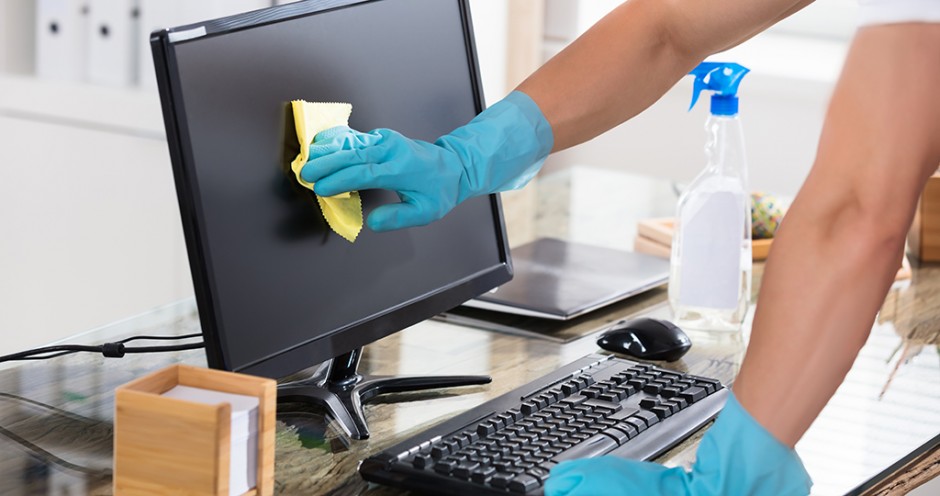The flu is one of the most common and deadly viruses that exists. This year is the first time that the flu is projected to be equally widespread across the United States1. It’s also projected to cause the highest amount of casualties, with 80,000 flu-associated deaths projected by year’s end2. As a result of its widespread and deadly nature, and with flu season approaching, the need to keep commercial buildings, such as office spaces, schools and health care facilities, free of the viruses’ germs is more urgent than ever before.
The flu virus can live on surfaces and remain contagious for upwards of 24 hours3—a period that’s more than enough time to devastate a workforce or student body, especially by way of high traffic areas. Common touchpoints like door handles or breakroom counters are prime spots for the flu to propagate and thrive, infecting with ease. By regularly disinfecting these surfaces and other commonly trafficked areas, the flu can be kept at bay in your office, school, store or healthcare facility.
As far as people go, the flu is contagious one day before an individual infected with the influenza virus starts to show symptoms, and up to one week after symptoms become apparent4. So, while the flu lasts on surfaces for about a day, it can last in a coworker, student or patient for a full week. With at least 26 percent of Americans still showing up for work when sick, the need for a thoroughly clean building, not to mention encouraged sick days, is crucial for maintaining productivity and keeping individuals happy and healthy. Here’s a few ways to keep the flu at bay in your commercial building.
How to Clean Up After a Sick Coworker
Let’s assume the worst has happened: a coworker or student was told to leave your building, or left of his or her own decision due to showing symptoms of the flu. Before panic sets in, in which your staff starts taking work-from-home days early or wearing sick masks in the office, there are steps you can take to reduce the probability and rate of infection when the flu made its way through your building.
First, do your best to quarantine the afflicted coworkers’ workspace and commonly touched items for at least one day. If that isn’t possible, thoroughly disinfect the afflicted coworkers’ workspace. For small work stations, you can simply use disinfecting wipes to sanitize desk surfaces, keyboards, phones and other touchpoints that the infected coworker engaged with on a regular basis.
It’s also a good idea to disinfect shared spaces such as breakrooms and bathrooms to reduce the risk of infection for others. Some heavily trafficked touchpoints that are often overlooked for cleaning include:
- Refrigerator handles
- Microwave buttons
- Water coolers
- Urinal and toilet handles
- Sink faucets and doorknobs
- Air hand dryers and paper towel dispensers
Though disinfection of affected workspaces can be helpful to combating the spread of a single breakout in a commercial building, when a mass outbreak of influenza hits your office or medical practice, it’s time to call in a commercial cleaning company to thoroughly disinfect your building.
How to Clean Up After a Sick Teacher or Student
Preventing the spread of the flu in a school comes with its own set of challenges as there are typically more bodies and additional touchpoints than in an office environment. Whereas coworker might linger at another person’s desk for a few minutes or upwards of an hour, students are sitting at a desk that was recently occupied by another student moments before. The chances of coming in contact with the flu are tremendous when there are so many shared surfaces where the virus can thrive up to a full day.
If a teacher or student leaves or is removed due to showing flu symptoms, there are a few things that can be done to lessen the chance of more students or staff from getting infected—and because it’s unlikely that a classroom can be quarantined during the day, janitorial staff may have to wait until the student body has left for the day.
Any surfaces that the infected person came into contact with including desks, lockers and other touchpoints should be disinfected ASAP. If the student is an athlete, the locker room should be disinfected fully to decrease the chance that the students’ respective teammates become infected and spread the flu to other areas of the school. If a teacher is infected with the flu, their office should be disinfected, as well as any break or staff rooms or lounges that he or she frequents.
Disinfecting for Flu Season with Commercial Cleaning
Commercial cleaning companies can reactively disinfect buildings that have been exposed to outbreaks of the flu, but the best use of a commercial cleaning is engaging with them in advance of an outbreak to prevent one altogether. Engaging a commercial cleaning company to routinely disinfect your building and its common and often overlooked touchpoints can keep your building free of infection all year long.
When a nasty outbreak of the flu has hit your building, commercial cleaning companies employ cutting-edge technology to assist with virus remediation. Technology such as electrostatic disinfection spray covers every conceivable surface and removes germs and bacteria, all with one simple and fast process: an electrically charged disinfectant covers every surface, sticking to the opposite charge and repels itself from the same charge, making it extremely effective for disinfecting all hard-to-reach surfaces.
Commercial cleaning companies also disinfect surfaces that are commonly overlooked by staff, or those that are too cumbersome for regular janitorial staff. This can include the sanitation of windows, the deep cleaning of carpets, and the disinfection of fan and shelf tops and other high, not-seen surfaces.
Need help protecting your building and staff against the flu this year? Contact a trusted commercial cleaning company for a consultation today.
Sources:


One thought on “How Long Does the Flu Last in Commercial Buildings?”
Comments are closed.